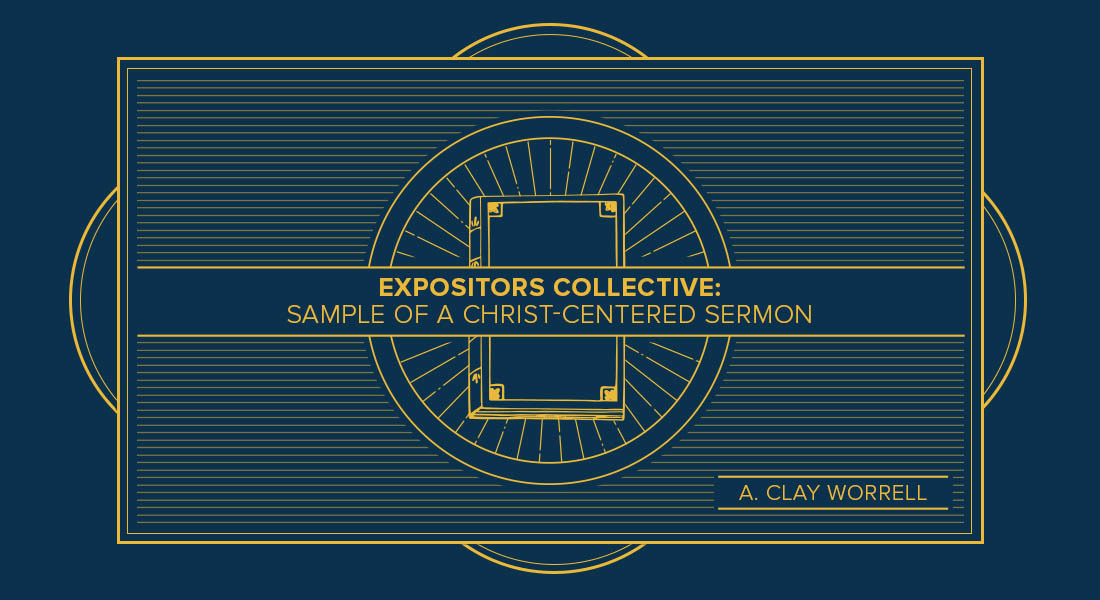
Recently, I was honored to take part in the Expositors Collective, a seminar designed to train and mentor young preachers in the skill of expository Bible teaching. My dear friend Mike Neglia taught a session on Christ-centered preaching, which he opened by highlighting the difference between a moralistic sermon and a Christ-centered sermon by first teaching a sample moralistic sermonette on Matthew 26:6-16, followed by me giving a sample Christocentric sermon on the same text. What follows is the transcript of my 10-minute Christ-centered sermon; perhaps it will be helpful for our Bible-teaching readers.
…
Matthew 26:6-16:
Now when Jesus was at Bethany in the house of Simon the leper, a woman came up to him with an alabaster flask of very expensive ointment, and she poured it on his head as he reclined at table. And when the disciples saw it, they were indignant, saying, “Why this waste? For this could have been sold for a large sum and given to the poor.” But Jesus, aware of this, said to them, “Why do you trouble the woman? For she has done a beautiful thing to me. For you always have the poor with you, but you will not always have me. In pouring this ointment on my body, she has done it to prepare me for burial. Truly, I say to you, wherever this gospel is proclaimed in the whole world, what she has done will also be told in memory of her.” Then one of the twelve, whose name was Judas Iscariot, went to the chief priests and said, “What will you give me if I deliver him over to you?” And they paid him thirty pieces of silver. And from that moment he sought an opportunity to betray him.
The Text
I would like to invite you to jump in to this story with me. We find ourselves with Jesus on His way to Jerusalem, almost there in Bethany. He is having dinner in the home of Simon the Leper.
Pause for a moment. It is so important as we read through scripture that we do not allow familiarity to rob us of the shock factor. A meal in the home of a leper! Do you remember the Levitical law about lepers? They were unclean; they could not live among anyone other than other lepers, if someone came near them, they would have to shout, “UNCLEAN!”
They were more marginalized than just about anyone in our society. Lepers did not have dinner parties. Yet Jesus and His followers were there at his house, reclining at the table, enjoying dinner. The only way this was possible was if Jesus had already healed Simon and made him clean. Jesus had not only healed Simon, but had brought him from isolation to community once again.
The opening scene of this story is one of redemption! Then we are introduced to an unnamed woman, who we know from John 12 is Mary, sister of Lazarus and Martha. Mary comes out while everyone is still at the table holding an alabaster jar. It would have been recognized by those present as the vessel to hold expensive perfume. She walks up to Jesus and the suspicions are confirmed as the overpowering scent of pure nard fills the room when she pours every drop of the oil over Christ’s head.
There is a gasp! That much nard was unfathomably valuable. (Estimated at almost $20K). The response in the room was from shock to outrage with some turning to her in rebuke. “Imagine the poor that could be fed with that much money!” Then Jesus speaks up: “Why do you trouble the woman? For she has done a beautiful thing to me. For you always have the poor with you, but you will not always have me. In pouring this ointment on my body, she has done it to prepare me for burial. Truly, I say to you, wherever this gospel is proclaimed in the whole world, what she has done will also be told in memory of her.”
Jesus affirms her actions, all the while pointing forward to the cross and the Gospel. Then our focus is brought to Judas. Undoubtably, as the treasurer of the group (who we are told was scraping off the top of the purse), Judas was the most offended by the financial foolishness. For him this was the last straw; he had lost faith in this Jesus that he had dedicated the last few years of his life to. He would cut his losses and turn Him over for thirty pieces of silver.
The Application
This is a dramatic story, but what does it teach us? Many things, but today I would like to focus on just three things it shows us about Jesus.
1) Jesus is in the business of redeeming, healing, cleansing and restoring.
As I mentioned, our opening scene sets the tone already for who Jesus is and what HE does. Simon the Leper was brought from isolation to community, from being unclean to being clean, from sick to well, marginalized to accepted. Why? Because He was with Jesus.
This is what Jesus does. We see it in His very mission statement quoting Isaiah 61 in Luke 4:18-19, “The Spirit of the Lord is upon me, because he has anointed me to proclaim good news to the poor. He has sent me to proclaim liberty to the captives and recovering of sight to the blind, to set at liberty those who are oppressed, to proclaim the year of the Lord’s favor.” This is what He has done in many of our lives, and this is what He will do for many more as they turn to Him.
2) Jesus is more valuable than any earthy thing, and Jesus is worthy of our worship.
It is worth noting that Jesus did not rebuke Mary for pouring out her life savings and her financial security on Him in a moment. He did not rebuke her for this act of worshipful adornment. Rather He affirmed her! Why? Because He is the God of creation that is worthy of all honor and glory and praise. Also, because trusting Him is more valuable than anything that this world has to offer!
As He said back in Matthew 6:19-21, “Do not lay up for yourselves treasures on earth, where moth and rust destroy and where thieves break in and steal, but lay up for yourselves treasures in heaven, where neither moth nor rust destroys and where thieves do not break in and steal. For where your treasure is, there your heart will be also.”
3) And finally, though Mary’s sacrifice and offering to Jesus was great, Jesus’ sacrifice and offering for each of us is infinitely greater!
Mary may have poured out her oil for Jesus, but Jesus poured out His very blood for Mary, and for you, and for me. Jesus, instituting the Lord’s supper, took the cup and said, “For this is my blood of the covenant, which is poured out for many for the forgiveness of sins” (Matthew 26:28). Mary may have surrendered her earthly riches for Jesus, but Jesus surrendered His heavenly riches for Mary, and for you, and for me.
“For you know the grace of our Lord Jesus Christ, that though he was rich, yet for your sake he became poor, so that you by his poverty might become rich” (2 Corinthians 8:9).
Mary may have been shamed and rebuked for her apparent foolishness for Jesus, but Jesus was scorned and rejected, mocked, tortured and killed for Mary, for you, and for me. “Looking to Jesus, the founder and perfecter of our faith, who for the joy that was set before him endured the cross, despising the shame, and is seated at the right hand of the throne of God” (Hebrews 12:2).
So what should our response to this be?
Should we be like Mary? Yes. But how and why? Because of who Jesus is, and what He has done for you. If Jesus was willing to sacrifice and give so much for you and I, to bring us forgiveness, liberty and hope, it is a small thing to lay down our temporal comfort, possessions or agenda. We love Him because He first loved us.









